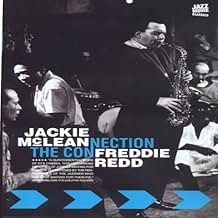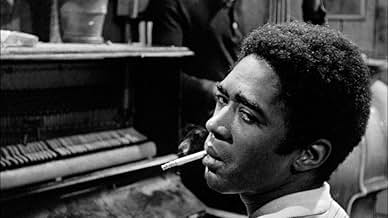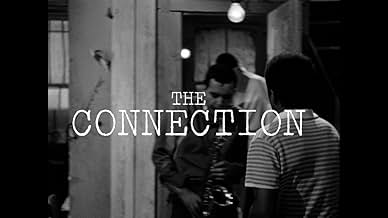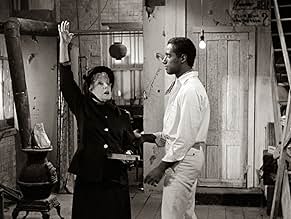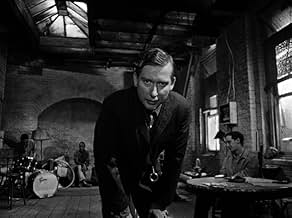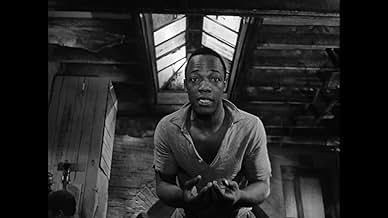IMDb रेटिंग
7.0/10
1.1 हज़ार
आपकी रेटिंग
अपनी भाषा में प्लॉट जोड़ेंMen sent their own way await heroin in Leach's apartment.Men sent their own way await heroin in Leach's apartment.Men sent their own way await heroin in Leach's apartment.
Jerome Raphael
- Solly
- (as Jerome Raphel)
Jim Anderson
- Sam
- (as James Anderson)
Roscoe Lee Browne
- J.J. Burden
- (as Roscoe Browne)
कहानी
क्या आपको पता है
- ट्रिवियाThis film was held up for release after the Board of Regents of the Motion Picture Division of New York State's Dept. of Education viewed the film and refused to grant it a license to be commercially shown. This was mostly due to the repeated use (seven times) of a four-letter word that rhymes with "hit" and is used as a slang synonym for heroin. The film was judged obscene but opened without a license anyway at the D.W. Griffith Theater on October 3, 1962, only to receive several bad reviews from the major N.Y. film critics. Director Shirley Clarke sued and a month later, the highest court in the state reversed the decision of the Board of Regents. However, the reputation of the film was already damaged and to this day, it has never recouped its original $167,000 budget.
- कनेक्शनFeatured in Cinéastes de notre temps: "Rome brûle" (Portrait de Shirley Clarke) (1970)
फीचर्ड रिव्यू
Regular readers of my comments know I study folding, and I suggest that it is a deep concern for many filmmakers going back many decades. Most of my viewing these days comes from reader suggestions.
This is one, and very interesting. Group it with "The Saragossa Manuscript" as an early experiment, probably influential. Crude and obvious, but of historical interest.
I will describe it because it is hard to find.
Ostensibly it is a documentary drama, filmed of then contemporary jazz musicians (man, dig?) in a seedy apartment. They are there for their pooled money to turn into a pooled high, then pooled music. The thing is framed by a device: the film is made by two people, the director and a photographer. During the film, the director has his first hit of heroin, and presumably succumbs to it thereafter. The movie starts with a statement by the photographer that the director has abandoned the project and he (the photographer) has assembled it for us.
In what we call the real world, this is a play about this film-making. So to begin, it is a film about a play (a very obvious play) about a film about a "real" drama. A theory of theater at the time was that such abstraction and acknowledgment of the medium would allow the form of the reality to shine through.
It is the theatrical equivalent of an architectural notion that you can see in the Paris Museum called Pompidou, where all the structure is more than exposed, exposed in a way so obvious it is supposed to be invisible.
You may buy this. I certainly did when I was an architect in this era until I actually designed a building using it.
The difficulties of making this work are enormous.
You can see those problems here. Cowboy is the agent who brings the high. He arrives in pristine white, an articulate black man who used to be a musician and now is a savior. He brings an old woman, a salvation army warrior from 70 years earlier, incidentally 70 years old and worried about her burial.
For this, you need extremely clean images, touchstone dialog (where you jump from pad to pad without muddying yourself), and actors who understand all the folds and can inhabit them all.
This has none of that. These are street performers after the manner of "The Living Theater" which eschewed just the kind of thinking this project demands.
What we end up with is a bunch of actors with empty lives without layers who give us a layered story about a bunch of musicians with empty lives because they left layers behind.
You'll probably want to watch "Hurly Burly" for something like this done well, or this for historical interest.
Ted's Evaluation -- 2 of 3: Has some interesting elements.
This is one, and very interesting. Group it with "The Saragossa Manuscript" as an early experiment, probably influential. Crude and obvious, but of historical interest.
I will describe it because it is hard to find.
Ostensibly it is a documentary drama, filmed of then contemporary jazz musicians (man, dig?) in a seedy apartment. They are there for their pooled money to turn into a pooled high, then pooled music. The thing is framed by a device: the film is made by two people, the director and a photographer. During the film, the director has his first hit of heroin, and presumably succumbs to it thereafter. The movie starts with a statement by the photographer that the director has abandoned the project and he (the photographer) has assembled it for us.
In what we call the real world, this is a play about this film-making. So to begin, it is a film about a play (a very obvious play) about a film about a "real" drama. A theory of theater at the time was that such abstraction and acknowledgment of the medium would allow the form of the reality to shine through.
It is the theatrical equivalent of an architectural notion that you can see in the Paris Museum called Pompidou, where all the structure is more than exposed, exposed in a way so obvious it is supposed to be invisible.
You may buy this. I certainly did when I was an architect in this era until I actually designed a building using it.
The difficulties of making this work are enormous.
You can see those problems here. Cowboy is the agent who brings the high. He arrives in pristine white, an articulate black man who used to be a musician and now is a savior. He brings an old woman, a salvation army warrior from 70 years earlier, incidentally 70 years old and worried about her burial.
For this, you need extremely clean images, touchstone dialog (where you jump from pad to pad without muddying yourself), and actors who understand all the folds and can inhabit them all.
This has none of that. These are street performers after the manner of "The Living Theater" which eschewed just the kind of thinking this project demands.
What we end up with is a bunch of actors with empty lives without layers who give us a layered story about a bunch of musicians with empty lives because they left layers behind.
You'll probably want to watch "Hurly Burly" for something like this done well, or this for historical interest.
Ted's Evaluation -- 2 of 3: Has some interesting elements.
टॉप पसंद
रेटिंग देने के लिए साइन-इन करें और वैयक्तिकृत सुझावों के लिए वॉचलिस्ट करें
विवरण
- रिलीज़ की तारीख़
- कंट्री ऑफ़ ओरिजिन
- आधिकारिक साइट
- भाषा
- इस रूप में भी जाना जाता है
- La conexión
- फ़िल्माने की जगहें
- उत्पादन कंपनियां
- IMDbPro पर और कंपनी क्रेडिट देखें
बॉक्स ऑफ़िस
- बजट
- $1,67,000(अनुमानित)
- चलने की अवधि1 घंटा 50 मिनट
- रंग
- पक्ष अनुपात
- 1.37 : 1
इस पेज में योगदान दें
किसी बदलाव का सुझाव दें या अनुपलब्ध कॉन्टेंट जोड़ें


